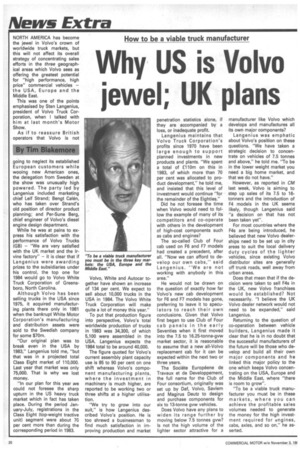Why US is Volvo jewel; UK plans
Page 22

If you've noticed an error in this article please click here to report it so we can fix it.
Volvo, White and Autocar together have shown an increase of 134 per cent. We expect to sell about 10,000 trucks in the USA in 1984. The Volvo White Truck Corporation will make quite a lot of money this year."
To put that production figure into perspective, Volvo's total worldwide production of trucks in 1983 was 34,300, of which 5,100 were assembled in the USA. Langenius expects the 1984 total to be around 40,000.
The figure quoted for Volvo's current assembly plant capacity use is 85 to 90 per cent on one shift whereas Volvo's component manufacturing plants, where the investment in machinery is much higher, are reported to be working two or three shifts at a higher utilisation.
"We try to grow into our suit," is how Langenius described Volvo's position. He is too shrewd a businessman to find much satisfaction in improving production and market penetration statistics alone, if they are accompanied by a loss, or inadequate profit.
Langenius maintains that Volvo Truck Corporation's profits since 1970 have been large enough to support planned investments in new products and plants. "We spent a total of £110m on this in 1983, of which more than 70 per cent was allocated to product development," he told me, and insisted that this level of investment would continue "for the remainder of the Eighties."
Did he not foresee the time when Volvo would need to follow the example of many of its competitors and co-operate with others in the development of high-cost components such as cabs and engines?
The so-called Club of Four cab used on F6 and F7 models had created a precedent, after all. "Now we can afford to develop our own cabs," said Langenius. "We are not working with anybody in this area."
He would not be drawn on the question of exactly how far Volvo's new cab development for F6 and F7 models has gone, preferring to leave it to speculators to reach their own conclusions. Given that Volvo first began to use Club of Four cab panels in the early Seventies when it first moved into the 7.5 to 16.25-tonne-gvw market sector, it is reasonable to assume that a new all-Volvo replacement cab for it can be expected within the next two or three years.
The Societe Europeene de Travaux et de Developpement, the full name for the Club of Four consortium, originally was set up by Daf, Volvo, Saviem and Magirus Deutz to design and purchase components for six to 13-tonne gvw vehicles.
Does Volvo have any plans to widen its range further by moving below 7.5 tonnes gvw? Is not the high volume of the lighter sector attractive for a manufacturer like Volvo which develops and manufactures all its own major components?
Langenius was emphatic about Volvo's position on these questions. "We have taken a strategic decision to concentrate on vehicles of 7.5 tonnes and above," he told me. "To be in the lower weight market you need a big home market, and that we do not have."
However, as reported in CM last week, Volvo is aiming to step up sales of its 7.5 to 16tanners and the introduction of F4 models in the UK seems likely, though Langenius said "a decision on that has not been taken yet".
For most countries where the F4s are being introduced, he believed that new Volvo dealerships need to be set up in city areas to suit the local delivery duty cycles of the lighter vehicles, since existing Volvo distributor sites are generally off trunk roads, well away from urban areas.
Does that mean that if the decision were taken to sell F4s in the UK, new Volvo franchises would be established? Not necessarily. "I believe the UK Volvo dealer network would not need to be expanded," said Langenius.
Returning to the question of co-operation between vehicle builders, Langenius made it clear that he is in no doubt that the successful manufacturers of the future will be those who develop and build all their own major components and he linked this major policy to the one which keeps Volvo concentrating on the USA, Europe and the Middle East, where "there is room to grow".
"To be a viable truck manufacturer you must be in these markets, where you can achieve the profitable sales volumes needed to generate the money for the high investment required for engines, cabs, axles, and so on," he asserted.








































































































